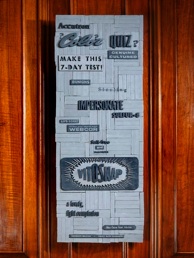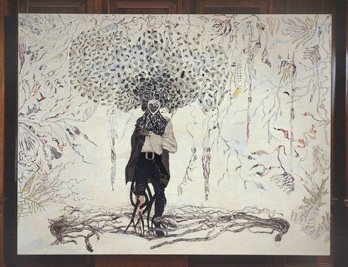I Like Hauser and Wirth
Prologue – the mirror
I like Hauser and Wirth. It’s good to say that. Not to write it or think it but to say it. This is the power of the spoken word and its impact upon the speaker. Not to think too much about it (it produces its own meaning) but to enjoy the words becoming audible and back again while staring at my face, smudge-eyed and vaguely anxious in the bathroom mirror.

1922 New Delhi
The London branch of Hauser and Wirth is housed in a 1922 Sir Edwin Lutyens designed Midland Bank building in Piccadilly and can be accessed through the front entrance. It is a gallery that is in some respects reminiscent of one of the larger rooms at the old Saatchi Town Hall in the ubiquity of polished oak panels cladding the walls. Rather than being used as a strong framing device, as in the often clumpy memories that float up from the Southbank, the clear monumentality of this oak bank interior was cleverly dispersed and integrated, and Hauser and Wirth’s architecturally/context-sensitive statement of intent presented at the outset, through a spillage of light and activity in the 2003 inaugural exhibition featuring Paul McCarthy’s site-specific video Piccadilly Circus. His video of the initial privately staged performance was multi-projected overlapping in time, and overlapping around the room rather than categorically directed at a particular point in a particular time frame. Overlapping also with the original set for the performance remaining in the center of the gallery with traces of the Queen Mother, Bush et al getting up to food stuffs that looked increasingly like foreign policy. The flood of clanking, hammering and leather apron shuffling spilt over the constructed wooden set and the oak panelling wherever it could and which in turn became integrated as part of the family abattoir sound itself. The ‘chaos’ and incongruity of this presentation suited the first impression of the Bank.
That was then. This is now - the summer of 2006
Volcanic trade in salt and slaves white gold, hair products, eyes and mouths
The interior of the Midland bank itself, without the reflecting half light cast by eye-watering Bushwanigans, comes across differently - with the lights up, as it were. Or at least that’s what occurred to me on visiting the Ellen Gallagher exhibition The Salt-Eaters at Hauser and Wirth, and the difference is again specific, I am sure, to this exhibition. I haven’t seen the interior of Hauser and Wirth without an exhibition in front of it, but what the exhibition was in front of this time is unmistakably a no longer functioning bank. Still with traces of its own 1920’s postwar commercial and imperialistic optimism, it predominantly imparts upon the perennial customer a day-to-day memory of personal banking. As such, and in this emptied state, this building has what appears to be its own qualities of the vaguely apocalyptic, particularly reminiscent of The Children of the Dammed and other grainy black and white films containing scenes of a near-deserted London in the 50’s and early 60’s.

Upon the oak panelling of this no longer functioning bank interior were Gallagher’s black-Irish-American nauseously obsessional wall pieces – small grid-like type settings and paste-ups, blond and the like Play-do intrusions upon advertisements for hair products and skin creams and larger expanding Hair and Oz-like drawings and collages made up of tiny eyes and mouths floating and disembodied from any face or solid point to speak of. They not so much framed the oak panels rather than infested them with their intense corrupt maggoty detail of past-imposed consumerism, and volcanic hallucinogenic eruptions. So this empty disused bank, with its own vaguely apocalyptical associations, was corrosively stitched together by a kind of strange act of time-warp woodworm (weaving in and out, in and out) with the building’s function on another level and at another time as a gallery.
This disturbing honeycomb of time and place was a slippage less shrouding than in McCarthy’s piece. I couldn’t remember, for instance, where the gallery staff were sitting on that inaugural day or even if they were there at all. Within the Gallagher exhibition I knew precisely where they were. They were established at the far end of the gallery when you walk in, behind what must have been the original desk (more like a pew) of the bank’s own former reception. It is oak and the top of their heads could just be seen to poke out above it like fresh pink organic matter in polyester navy blue suits and white blouses. Also clearly visible was a cctv monitor on the desk, showing murky cameronesque-underwater shots of the basement where a large safe was just visible in the darkness. In the basement itself, in one of the vaults to the left of the safe, was a small black and white 16 mm fragment of the ocean horizon, changing in light quality projected on the greasy wall. The scratched and worn fragment itself was silent but was accompanied by the functional hum and clatter of the heavy projector. Back upstairs at the desk there was a real and awkward silence, the kind of patient voiceless silence brought on from watching others engaged in business. Reminiscent of being in a queue
A small oak compartment.
In the very elegantly titled Blow de la Barra Gallery on Heddon Street is an exhibition entitled The Title of the Exhibition as an Artwork. A complex and multi-layered exhibition in a more organised and graspable sense but with its own impacts. The title is taken from an online source of exhibition titles, generously set up by Stefan Brüggemann and freely available for anyone to use. The title, The Title as an Exhibition as an Artwork, is #347 and was chosen (one assumes, but probably delegated to someone else) by the curator Mathieu Copeland. Paintings (in the expanded sense of the word) and the spoken word itself also contribute to this exhibition that the on-going Copeland, both selects and then integrates within a larger and increasingly growing warez-style website. Within the main conventional white cube gallery space Claude Rutault and Jaroslaw Flicinski both dealt with painting in a combination of Lukas & Sternberg white retinal imprint wall painting (Flicinski) and slapstick remnants of a Charlie Drake sketch involving white paint, overalls, buckets and ladders, in which a painting purchased at Bonhams Auction House was hung up and painted over whilst preparing the space (Rutault). The noise of this part of the exhibition was wisely covered up and left as a memory in respect to the piece as title and the spoken word exhibition.

Behind the screen of this painting imprint was Rebecca May Marston, one of the two directors of Blow De La Barra, who had to be approached to deliver the voice pieces, which she did standing up with one arm. These pieces were short written pieces supplied either daily, as a batch, or as a single statement to be repeated the same each day, that were then read to the visitor on request. Some that would have been newly supplied each day, or from the circulating batch were perhaps never heard, depending on the attendance levels to the exhibition, a fact that almost seems Japanese. Practiced but slightly irritated she read the pieces from the white sheet, a white sheet that I was grateful for and perhaps she didn’t need, but anything less would appear directed specifically at me from her. The paper became the mediator in this case. She didn’t start with Nick Currie’s (AKA Momus) Chinese Whisper, but it was the most uncomfortable, not because of what was said but because of the simultaneous reestablishment of my own voice. The piece was hard to hear not because of the pressure of business-like exclusion (rudeness), but because it was not whispered in my ear. Rebecca whispered something at me, and not in my ear. I thanked her, loud and clear. As it was a Chinese Whisper I don’t think it mattered that I missed it. Lawrence Weiner’s piece, on the other hand was spoken clearly, was its own title, and whose effect was not unlike asking gallery staff a question. In that sense, formal to the last. Ian Wilson is short and sweet. The delivery was straightforward and to the point – ‘Time’. A singular spoken word can engender more confidence than a sentence, drawing as it does on memories of the imperative. Karl Holmqvist’s Genet clip was in French and added another layer to our moment. Douglas Copeland was quasi-futuristic trash statement gathering in the recesses of hyperspace and delivered with a mind elsewhere. It went on I guess, until the very last word was spoken. I wanted to talk and made some comment about short straws and gallery directors, strain and how I was often in need of the occasional statement uttered without too many ties. All this was gentle and trivially ice breaking. However, what had been dislodged was a thought. The spoken word had dislodged a thought that had been placed up in my cranium a little earlier when navigating the tiny stone steps from the bank vaults to surface by the desk of Hauser and Wirth. A thought of how Gallagher had presented a glimpse of that which McCarthy had shrouded in his momentarily conservative assertions, through her own exposure, via her own navigations, of the architecture and apocalyptic nature of grainy authoritarian post-war London and its effect upon the unwitting staff of Hauser and Wirth. A glimpse of queuing up to queue up to get back where I came in, eating my own slightly distant tail and in this spiral, observing two members of polyester-clad staff locked in private business with the effect of a sharp and sudden loss of oxygen that extinguished my voice, silently, in an instant, without me even noticing. Maybe it was sometime in the 1920’s or maybe the ‘50’s, maybe it was New York, London or Rotterdam, doubtful it was Cape Verde for all the promises. Wherever it was, the voice had gone in a form of respectful 16mm silent waiting while other voices were animated, busy and whirring, ticker-tape-like. Whilst a tautology that was a product of particular circumstances and complicated by the different levels with which the work of Gallagher brought together or exposed as a glimpse, it is none the less a glimpse into a small draw of an old oak desk that leaves one momentarily silenced with only the possibility of exercising and strengthening beforehand or afterwards the timbre of one’s voice, smudgy in the bathroom and thinking of Rebecca – I like Hauser and Wirth.